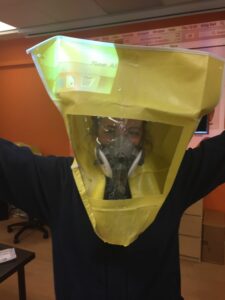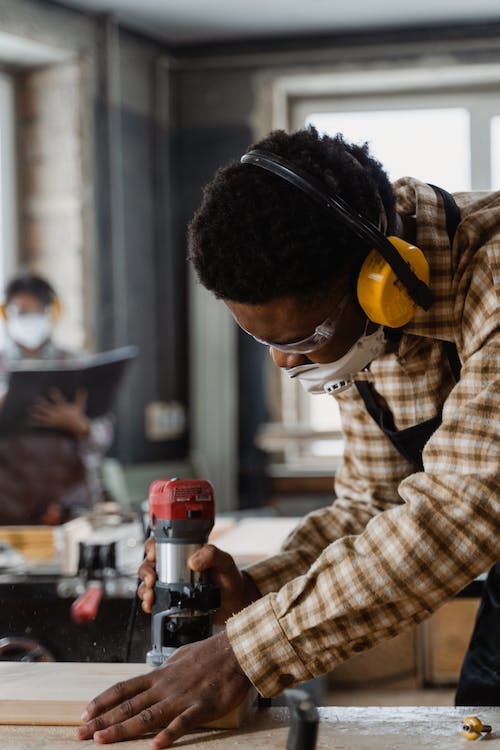Carpenters face a unique set of occupational hazards therefore, you must remain safe and protected. Also, ensuring the safety of the people around you. With a lot of risks to consider, it's important to be aware and promote safety to your fellow colleagues. This article is to discuss the importance of masks, also known as respiratory protective equipment.
Asbestos:
Asbestos is a naturally occurring fibrous silicate mineral that are resistant to heat and corrosion. If products containing asbestos are disturbed, tiny asbestos fibres are released into the air. When asbestos fibres are inhaled, they may get trapped in the lungs and remain there for a long time. Working with asbestos present can create long-term health issues if exposed repeatedly or for long periods of time. Asbestos-related diseases usually happens 20 to 50 years after exposure.
According to Thompsons Solicitors, in the UK, more than 5,000 people die annually as a result of asbestos related diseases. Asbestos exposure is also the biggest cause of work-related deaths in the world.
The professions traditionally most at risk from exposure to asbestos are:
- Carpenters
- Insulators
- Boilermakers
- Mechanics, etc.
Wood Dust:
Wood dust is another inhalation risk like asbestos, wood processing causes small particles of wood dust to become airborne. Workers then breathe in those particles. The small particles can go deep into the lungs causing damage and scarring to the lung tissue. The damage reduces the lungs' ability to take in oxygen and over time, causes difficulty in breathing. Wood dust can also cause nasal cancer.
Side effects can be irritation, coughing, or sneezing caused by the dust. Exposure to wood dust can irritate your eyes, nose, and throat. Workers can also experience shortness of breath, dryness, and sore throat, conjunctivitis, and rhinitis.
Activities such as sawing, cutting, and sanding are likely to cause high dust exposures leading to the possible side effects stated above.
Choosing the correct Respirator for Carpentry
Carpenters may think by wearing a basic surgical mask is sufficient protection from breathing in any harmful particles. In short, this is not adequate protection for the job that they are doing. There is no seal around the mask therefore, you are at risk of inhaling the particles in the air.
There are many different types and styles of RPE. You can get disposable masks, half and full-face respirators. While you may be used to wearing a half-face mask and protective eyewear, a full-face mask may be more convenient.
The type of mask and filters worn will be decided on what hazards you could expose yourself to. Respirator masks are designed to help reduce the wearer's exposure to airborne contaminants such as particles, gases, or vapours.
Respirators and filters must be selected based on the hazards present. They come in various sizes and styles and should be individually selected to fit the wearer's face and provide a tight seal. A proper seal between the user's face and the respirator forces inhaled air to be pulled through the respirator's filter material, therefore, providing protection. A trained fit tester will need to perform a fit test to ensure the mask you are wearing fits you correctly. We do not all have the same size and shape faces; therefore one mask cannot fit all.
Whatever you decide, you need to look at the risks you expose yourself to daily to ensure you have the correct mask and filter for your protection.
- Moulds, fungi, and bacteria.
- Chemicals, solvents, paints, stains, and other materials which may result in dermatitis, allergic reactions, or respiratory problems.
- Cancer risk from certain wood dusts.
- Risk of eye injury from flying particles.
Inhaling wood dust is the main cause of occupational asthma.
What are the requirements?
Before your fit test there are a few requirements you must follow. You must:
- Not eat or drink within 30 minutes of the fit test (excluding unflavoured water)
- Not chew gum, smoke, or vape within 30 minutes of the fit test
- Bring some form of photographic ID with you
- Within the last 8 hours, ensure the mask seal area has been clean shaven
- Remove any makeup within the mask seal and have long hair tied back
- Bring any head worn personal protective equipment that you wear with your mask
- Bring glasses if you wear them with your mask.
Extra precautions Carpenters should take
Using RPE/ PPE will help protect the worker. You should look at the source causing the harm to see if you can eliminate or reduce the hazards first.
- Clean up wood dust regularly and maintain good housekeeping.
- LEV - local exhaust ventilation system. Used to filter out harmful wood.
- Dust lamps can help track and control dust dispersion by illuminating extra-fine dust not visible to the naked eye.
- According to Occupational Safety and Health Administration, workplaces which contain one or more machines that create dust, shavings, chips, or slivers during a period of time equal to or greater than one-fourth of the working day need to be equipped with a collecting system. Protective equipment for the eyes and mouth is crucial.
Fit Testing with Cavity
A face fit test is a simple and quick procedure that can prevent many health issues and possible fines to your business. We can come to your premises to carry out yours and your teams fit test. We also are able to perform fit tests at our head office in Wokingham. You’ll need to bring the mask you’re currently using or going to use. A risk assessment to determine what type of mask and the level of protection you'll need. Your employer should perform this task.
Qualitative Fit Testing Method
Qualitative fit testing is a pass/fail test based on the wearer’s subjective assessment of any leakage through the face seal region by detecting the introduction of bitter – or sweet-tasting aerosol as the test agent. QLFT methods are suitable for disposable and reusable half masks, they are not suitable for full-face mask. At Cavity, we offer a fit test service for FFP3, FFP2, and FFP1 masks.
the test agent. QLFT methods are suitable for disposable and reusable half masks, they are not suitable for full-face mask. At Cavity, we offer a fit test service for FFP3, FFP2, and FFP1 masks.
Quantitative Fit Testing Method
Quantitative fit testing is the process to measure the precise amount of leakage into any tight-fitting facepieces. A machine (Porta Count) calculates measurements instead of relying on bitter-tasting chemicals and your senses. The reading on the porta count machine will determine if the mask has an adequate seal with the wearer’s face.
Within our team, we have several Fit2Fit accredited fit testers with experience in face fit testing. Our methods have been checked and confirmed with the best practice for face fit testing in line with BSIF and HSE. Good knowledge and technique are essential when conducting a fit test, poor execution could result in workers being exposed to dangerous hazardous substances.
Don't get caught short of protecting yourself, or your work force.
Be safe!
Stay protected!
Book your fit test!
